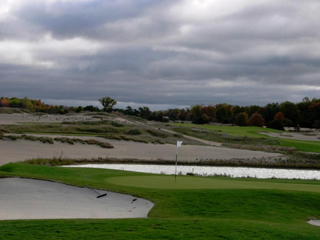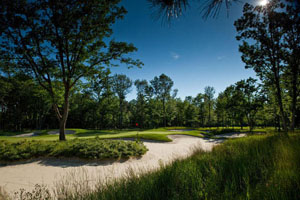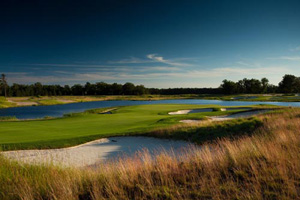Featured Golf News
Splendid Isolation at Michigan's Forest Dunes Golf Club
There's no doubt that the tree-choked, slightly rolling land just northeast of Roscommon Township, Michigan (population 1,133), is an isolated place, a destination travelers have to want to visit rather than happen onto.

Forest Dunes Golf Club
These wooded hills and white-sand dunes have been carefully molded under the hand of Tom Weiskopf into one of the nation's top golf courses - Forest Dunes Golf Club. Here, splendid isolation is a big part of the appeal of the overall experience, and the course is one that golfers, hackers and golf-architecture aficionados all clamor to visit.
Weiskopf, the former British Open champion and designer of scores of great courses, considers Forest Dunes one of his three top efforts. And the track is proof in the pudding.
Forest Dunes has been always been a media darling, ranking No. 45 on Golf Magazine's list of the nation's top-100 courses. Golf World readers selected it as the top public course in the country and it's a perennial choice on Golfweek's list of its top-100 modern American courses. The venue has also been lauded by just about everyone who's made their way to Michigan's backcountry.

Immaculate Conditioning is
a Hallmark at Forest Dunes
Forest Dunes' geographic isolation has made it financially problematic and the club has struggled to survive the recent economic challenges. Things are looking up, though, as the property was recently purchased by Lew Thompson, a trucking company magnate from Huntsville, Ark. Thompson is also the managing member of the partnership that owns and operates Bridges Golf and Country Club on Colorado's Western Slope city of Montrose.
Thompson has set in motion an ambitious plan to assure that the club can thrive, part of which is a 22-room hotel with four luxury suites that will be attached to the club's expansive Adirondack lodge-style clubhouse. Thompson said he is planning to have the hotel open by mid-2013.

The Seventh Green at Forest Dunes
Colorful History
Forest Dunes was once part of a large parcel owned by William Durant, the founder of General Motors. Durant also owned a 1,500-acre parcel known as the Mason Tract, just east of Forest Dunes.
In the 1930s Durant sold the 1,200-acre parcel that now contains Forest Dunes to the Detroit Partnership (the collective name for the Tocco, Licavoli and Zerilli families that comprised the "Motor City Mafia").
Then called the South Branch Ranch, the property served as the private hunting grounds for the crime families and their colleagues, and legend has it that machine gun-toting guards protected the property. Teamster Union chief Jimmy Hoffa was a regular visitor, leaving some to speculate that he might still be a permanent fixture (now that's a real hazard!).
After its debut in 1998 Forest Dunes was plagued by financial woes, almost closing mere months after opening. In 2001, the Detroit Carpenters Union Pension Trust Fund took over the ownership of the course and carried it until Thompson became the proprietor.
The course is set along the western border of the 40,000-acre Huron National Forest in an environmentally sensitive area near Au Sable River, one of the nation's top fly-fishing venues.
Efforts to protect the river earned Forest Dunes the highest level of recognition a golf course can receive - a Gold Signature Certification from Audubon International. Only 21 other golf properties in the world have that certification, and Forest Dunes is the only such course in Michigan.

Forest Dunes GC's No. 9 Green & Clubhouse
Two Sides, Two Types of Terrain
Par-72 Forest Dunes stretches 7,141 yards from its back set of four tees, where it has a rating of 74.8 and a 142 Slope. The course features two distinct nines - the tree-lined "forest nine" heads out and the more-open "dunes nine" is the home half.
The course boasts white-sand bunkers that accentuate the verdant fairways and greens, and water borders five holes. Generally, there's plenty of safe space near the putting surfaces, with open areas in front allowing a bump-and-run approach. That said, missing greens can extract extra strokes as the putting surfaces are severely sloped and quick.
After the dunesy, 399-yard par-4 opener, the first real challenge is found at the 451-yard par-4 second, which is laterally treed the length of the fairway before ending at a green protected short and left by a huge bunker. There are bunkers surrounding the 208-yard par-3 third.
The fifth, a 602-yard par-5 that plays downhill to a landing area and further downhill to the green, offers a wider route. But beware of two deep bunkers along the right of the fairway and another even larger one back and right of the green.

The 16th at Forest Dunes
A towering tree separates the fairway on the 375-yard, par-4 sixth and, on the seventh, a 531-yard par-5, the green is tucked behind two tall trees, one of which is in the bunker at the right-front.
The wide, 448-yard par-4 eighth curls to the right at the 200-yard mark. Big hitters can carry their drives over the right-side bunker complex to the 130-yard landing area and find a great scoring opportunity. The approach here is one of the most beautiful on the course: downhill to a green guarded by a water hazard short and right and three sand bunkers at the rear.
The course ventures out of the forest at the 203-yard par-3 ninth, which calls for a healthy carry over water to a green ringed by further imperiled by five bunkers.
With a few exceptions, the back nine is almost entirely on wide-open, sandy dunes. The 479-yard par-4 10th has a split fairway separated by a huge bunker and an upside-down "U-shaped" green with ridges at its left and right-center.
At just 373 yards, the par-4 13th isn't alarming when viewed on the scorecard. But once on the tee, Weiskopf's flair shows. The tee shot has to carefully fit between two pines, and the slightly domed green tends to repel approaches into a cavernous bunker at the right.
The 464-yard 14th has a links look, with fescue surrounding the sculpted tees and numerous bunkers bordered by high grasses and thick rough. A massive fairway trap lurks along the right at the 175-yard mark, and water runs from this juncture all the way to the green.
A drive over a natural area starts the 558-yard par-5 15th, with bunkers right and trees left squeezing the fairway near the 250-yard spot. Long hitters may be tempted to go for the green in two, but if this hole is played as a three-shotter a safer score is possible.
There is water left and room right of the drivable 302-yard par-4 17th (Weiskopf's signature design treatment at Forest Dunes and other courses), inviting a tee shot to the green between three bunkers. But it seems like there are miles of sand dunes on both sides of the fairway.

No. 18 Green at Forest Dunes GC
The closer, a par-5 of just 531 yards, offers another scoring opportunity. Because the green is slightly downhill from the landing area, it can be readily reached. But a lake that runs along the left side of the hole and wraps around the back of the green and a waste area right causes players to pause before going for broke.
As if 18 holes wasn't enough, Weiskopf built a 19th hole, an uphill 119-yard and across-the-water gem with a Riviera-esque bunker in the middle of the green. Complementing the layout is a fine practice facility and a two-and-a-half-acre putting course.
Forest Dunes is about a two-and-a-half-hour drive from the northern suburbs of metropolitan Detroit and less than 15 miles off I-75 at Exit 239. There's no doubt this course is worth the trouble to find. It is a must-play in the Wolverine State.
For more information, visit http://www.forestdunesgolf.com.
Steve Habel is one of Cybergolf's world correspondents, contributing news stories, features, equipment and book reviews and personality profiles from his base in Central Texas. He is also works as a contributing editor for Horns Illustrated magazine, a publication focusing on University of Texas sports, covers the Longhorns for CBS Sports, is regional editor for Texas Golfer magazine and files stories for Golf Oklahoma magazine, Texas Links magazines and Golfers Guide. Habel's main blog (www.shotoverthegreen.blogspot.com) features news on golf and the Longhorns, and another (www.checkinginandplayingthrough.blogspot.com)chronicles his many travels, on which he has played more than 350 golf courses since 2009. Habel is a member of the Golf Writers Association of America and the Texas Golf Writers Association.
Story Options
 |
Print this Story |
